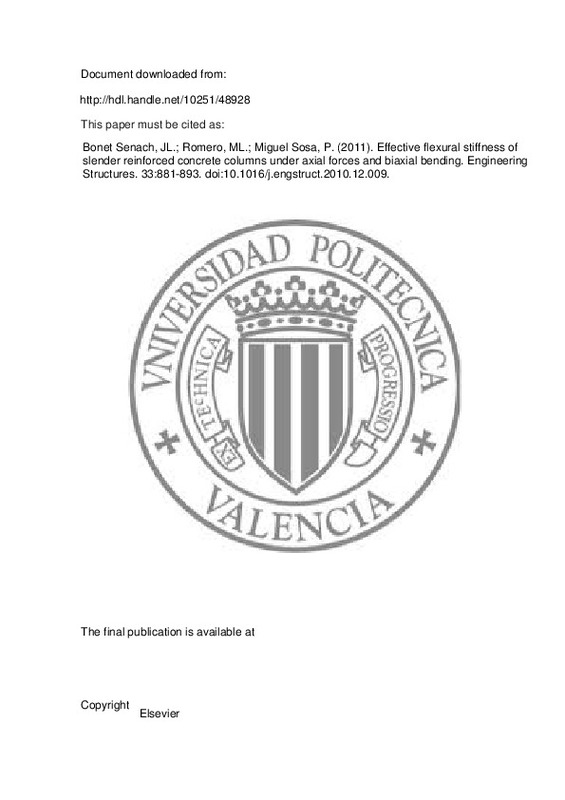Barrera Puerto, A.; Bonet Senach, JL.; Romero, ML.; Miguel Sosa, P. (2011). Experimental tests of slender reinforced concrete columns under combined axial load and lateral force. Engineering Structures. 33(12):3676-3689. https://doi.org/10.1016/j.engstruct.2011.08.003
Por favor, use este identificador para citar o enlazar este ítem: http://hdl.handle.net/10251/49003
|
Título:
|
Experimental tests of slender reinforced concrete columns under combined axial load and lateral force
|
|
Autor:
|
BARRERA PUERTO, ANGELA

 Bonet Senach, José Luís
Bonet Senach, José Luís

 Romero, Manuel L.
Romero, Manuel L.

 Miguel Sosa, Pedro
Miguel Sosa, Pedro
|
|
Entidad UPV:
|
Universitat Politècnica de València. Departamento de Ingeniería de la Construcción y de Proyectos de Ingeniería Civil - Departament d'Enginyeria de la Construcció i de Projectes d'Enginyeria Civil
Universitat Politècnica de València. Departamento de Mecánica de los Medios Continuos y Teoría de Estructuras - Departament de Mecànica dels Medis Continus i Teoria d'Estructures
|
|
Fecha difusión:
|
|
|
Resumen:
|
The use of high strength concrete (HSC) in columns has become more frequent since a substantial reduction of the cross-section is obtained, meaning that slenderness increases for the same axial load and length, producing ...[+]
The use of high strength concrete (HSC) in columns has become more frequent since a substantial reduction of the cross-section is obtained, meaning that slenderness increases for the same axial load and length, producing higher second order effects. However, the experimental tests in the literature of reinforced concrete columns subjected to axial load and lateral force focus on shear span ratios, according to Eurocode 2 (2004), clause 5.6.3., (M/(V·h)) lower than 6.5. This gap in the literature limits technological development for the construction of these structural elements. This paper presents 44 experimental tests on reinforced concrete columns subjected to constant axial load and monotonic lateral force. The aim of this is to gain greater knowledge of the types of elements which will also be of use in calibrating the numerical models and validating the simplified methods. The test parameters are strength of concrete (normal- and high-strength concrete), shear span ratio, axial load level and longitudinal and transversal reinforcement ratios. The strength and deformation of the columns were studied, and an analysis of the simplified methods from Eurocode 2 (2004) and ACI-318 (2008) concluded that both are very conservative. © 2011 Elsevier Ltd.
[-]
|
|
Palabras clave:
|
Columns
,
Experimental tests
,
Monotonic
,
Reinforced concrete
,
Slenderness
,
Axial load level
,
Eurocode2
,
Experimental test
,
High strength concretes
,
Lateral force
,
Numerical models
,
Reinforced concrete column
,
Second order effect
,
Shear span ratio
,
Simplified method
,
Slender reinforced concrete columns
,
Strength of concrete
,
Structural elements
,
Substantial reduction
,
Technological development
,
Test parameters
,
Transversal reinforcement
,
Columns (structural)
,
Concrete buildings
,
Concrete construction
,
Numerical methods
,
Shear strength
,
Testing
,
Axial loads
,
Building code
,
Column
,
Deformation mechanism
,
Experimental study
,
Loading
,
Model validation
,
Numerical model
,
Shear strain
,
Shear test
,
Standard (reference)
|
|
Derechos de uso:
|
Reserva de todos los derechos
|
|
Fuente:
|
Engineering Structures. (issn:
0141-0296
)
|
|
DOI:
|
10.1016/j.engstruct.2011.08.003
|
|
Editorial:
|
Elsevier
|
|
Versión del editor:
|
http://dx.doi.org/10.1016/j.engstruct.2011.08.003
|
|
Código del Proyecto:
|
info:eu-repo/grantAgreement/MICINN//BIA2009-10207/ES/Diseño Con Criterios De Ductilidad De Uniones Soporte-Cimentacion En Elementos Prefabricados De Hormigon/
|
|
Agradecimientos:
|
The authors wish to express their sincere gratitude to the Spanish Ministry of Science and Innovation for the help provided through project BIA2009-10207 and to the European Union for the financial support from Feder funds.[+]
The authors wish to express their sincere gratitude to the Spanish Ministry of Science and Innovation for the help provided through project BIA2009-10207 and to the European Union for the financial support from Feder funds.
[-]
|
|
Tipo:
|
Artículo
|







![[Cerrado]](/themes/UPV/images/candado.png)



